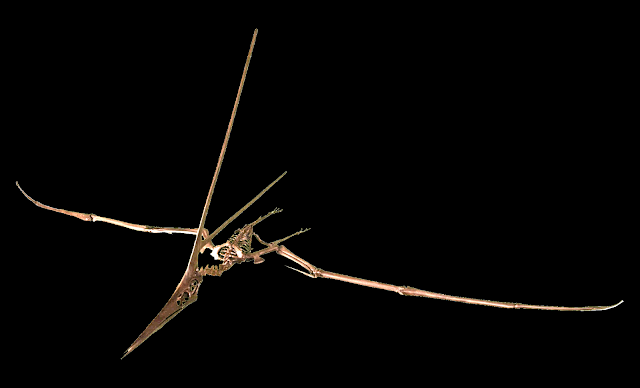Although fossils are normally found in rocky sediments
layered together for millions of years from geologic processes, plenty of
exceptions are made. Fossils can also be found in rather loose substrates, like
clay pits. One such discovery, the first of American Dinosaur origin, was made
in a marl pit on a small tributary of the Cooper River in Haddonfield, New
Jersey, which eventually came to be known as the Woodbury Formation.
(Image credit: Wikimedia Creative Commons)
The specific marl pit to brandish fossils was on the property of farmer, John Estaugh Hopkins. Hopkins was first to find something in the marl pit in 1838. Embedded in the clay were a number of large, fossilized bones. Hopkins was not exactly looking for them, as he wanted nutrient-rich marl clay to fertilize his farm; however, the fossils were curious enough to keep, and he displayed them in his home for a time. Fossils make great conversation pieces, so no doubt visitors saw the bones and interpreted any number of things.
(Image credit: Wikimedia Creative Commons)
Twenty years passed before the bones inspired someone to go to the same mud-pit and find the rest of the skeleton. William Parker Foulke, a Quaker, philanthropist, abolitionist, and geologist, was just that person. Curious about the fossils, he asked Hopkins if he could see them, but the farmer apparently had grown bored of the bones and disposed of them without ceremony or thought. Perhaps more lay in the marl, thought Foulke, and was granted permission to search the clay and silt.
And so the black bones, newly excavated, were wrapped in cloth, covered in hay, and hauled to the Academy of Natural Sciences in Philadelphia to be studied by Foulke and the academy’s paleontologist Joseph Leidy.
(Image credit: T. Jordan Wompierski and Jersey Man Magazine)
It was not an entire skeleton, just the left half without a skull, either. The find did include; limbs, half a pelvis, twenty-eight vertebrae, and a few teeth—35 bones in total. Leidy’s imagination fired and interpreted not bison or mammoth or world-flood casualty, but a dinosaur—a member of a newly named branch on the tree of life. This dinosaur was unique. It was no lumbering, quadrupedal hulk like those recently described in England. No, this animal had grace and was able to stand on its hind legs, holding its head aloft among Cretaceous conifers. Leidy named it Hadrosaurus foulkii, “Foulke’s bulky lizard,” to honor the man who’d finally given the bones the attention they deserved.
(Image Credit: Wikimedia Creative Commons)
An artist was dispatched—Benjamin Waterhouse Hawkins. An English artist with an eye for detail and drama, he took Foulke’s bones and Leidy’s ideas and constructed a skeleton lanky and pensive, like a dancer paused in thought. Hawkins sculpted a blunt head, iguana-like, but bearing the battery of unique grinding teeth found in the marl. The mount was a sensation.

(Original Skeletal Mount; Image credit: Wikimedia Creative Commons)
Those same bones from the mud remained the only Hadrosaurus fossils known. No additional specimens have been uncovered from the original site or any other. The 1868 mount was disassembled, but the fossils remain at the Philadelphia Academy of Natural Sciences. Casts of them can now be seen there on display. The originals are too precious for public viewing and remain in the Academy’s vaults, some still in wooden boxes Leidy crafted just for the bones.
In the 150-plus years since the discovery of Hadrosaurus foulkii, other species have been assigned to the genus: H. mirabilis and H. cavatus. These have since been found to belong to other genera. The fossils were also referred to Ornithotarsus immanis for a time, even being considered a nomen dubium due to the fragmentary status of the original fossils, but Hadrosaurus foulkii remains a valid taxa leaving its name remaining as the type specimen of the entire family, the Hadrosauridae, a legion of mallard-faced saurians sporting various crests and knobs.

Due to evolutionary association, it can be reasonably assured Hadrosaurus was duck-billed with jaws that chewed in four directions to grind vegetation into pulp. It likely had thick, pebbly skin. It could stand on two legs as Leidy once hypothesized; skeletons of young hadrosaurids suggest bipedalism was the norm until adulthood, when the animal would spend most of its time on all fours. It may have been gregarious, nesting in colonies, and feeding its hatchlings before they could walk. Radiometric dating of the marl pit reveal Hadrosaurus foulkii lived during the Cretaceous Period, between 80.5 and 78.5 million years ago.
Hadrosaurus was the first dinosaur find of the United States and the first mounted dinosaur skeleton in the world. In 1991, it was named the official state dinosaur of New Jersey. It was also to be a star of the Paleozoic Museum, a proposed paleontology-focused glass and iron palace in New York’s newly created Central Park. Here Hadrosaurus would cavort with Laelaps and plesiosaurs, glyptodonts and Irish elks, all carefully crafted by Benjamin Waterhouse Hawkins. Hawkins’s plans show more than one life-sized model of the creatures in the exhibit—one standing tall, almost defiant against a crouching theropod, another at rest, like a great, reptilian house cat, legs folded, tail wrapped around its scaly body. Sadly, Hawkins inserted himself into local civics by speaking against “Boss” Tweed, a corrupt local politician, and Tweed’s hoodlums destroyed the artist’s studio, smashing every sculpture and mold, burying the fragments and dust under the park.
However, Hawkins was not done with Hadrosaurus. He submitted sketches for a proposed exhibit at for
the Smithsonian Institution where a sculpture of the duck-bill would stand as
the centerpiece. He sculpted another skeleton for exhibitions in Philadelphia
and Washington D.C. on the occasion of the Declaration of Independence’s
centenary. And he painted a herd of the beasts in a Romantic landscape, alive,
rearing against predators and cavorting beside a plesiosaur-choked beach under
a bright blue Cretaceous sky.





























































































































